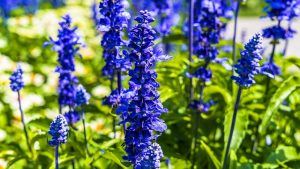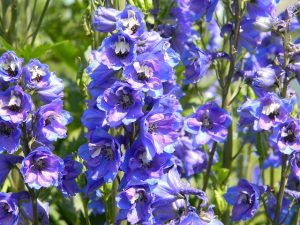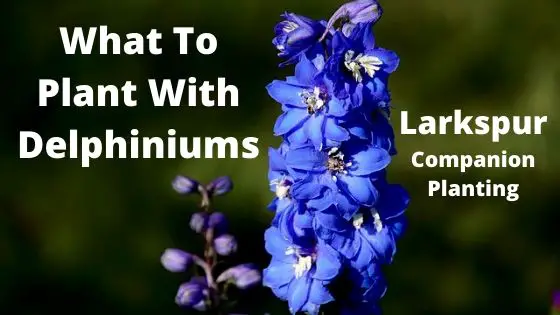Delphiniums have the common name of Larkspur, so this post could also be called what to plant with delphiniums/larkspurs. It used to be thought that delphiniums were perennials and larkspur annuals, but this has been disproved by scientists. Ranging in size from 1 foot to 7 foot tall, and in colour from pink, blue, red, or white flowers, they make attractive garden plants.
Where Do Delphiniums Originate?

Delphiniums are found throughout the Northern hemisphere and in mountainous regions of Africa. The Ancient Greeks supposedly named them because the flower shape reminded them of dolphins. In Mountainous regions of the United States they grow wild and cause serious problems for ranchers.
Which Plant Family Do Delphiniums Belong To?

Both delphiniums and larkspurs are members of the Ranunculacaeae family, other plants in this family include:-
- Buttercups
- Anemone
- Aconites
- Clematis
- Columbine
- Hellebore
- Monk’s hood
All of the plants in this family are toxic to humans and animals. With death occurring within 60 minutes in severe cases. If treated quickly patients can make a recovery, but only if treated quickly.
A Word Of Caution When Growing Delphiniums

All parts of the plant are poisonous, that’s both delphiniums and larkspurs. This is why they are problematic to U S ranchers and why as gardeners we need to be aware. Humans, pets and wildlife, are all at risk from delphinium poisoning, the symptoms of which are severe digestive pain and skin irritation.
What To Plant With Delphiniums

Any plant that grows in full sun or partial shade will do well with delphiniums and larkspurs. They are well worth growing in the vegetable garden because this is where their toxicity can be used to our advantage.
For more information on delphiniums follow this link to the North Dakota State University web page.
Which Pests Are Affected By Delphiniums?

The Japanese beetle is a pest that can devastate plants in a very short time, and are attracted to delphiniums. Fortunately the toxin in the plant kills them thus eradicating the problem. Also attracted to delphiniums are:-
- Aphids
- Leaf miners
- Slugs
- Spider mites
Again as the plant is toxic these pests don’t last long, however, caution is needed as humans have died from delphinium toxin. It’s not just pets and livestock or insects. For more on plants that repel aphids follow this link.
Companion Planting Delphiniums

Depending on the variety grown they can be incorporated into many garden displays. Delphiniums look attractive and they keep pest populations down. Try growing some in your vegetable beds to see a reduction in crop damage.
What Beneficial Insects Are Attracted To Delphiniums?

As already stated delphiniums attract unwanted pests, but they also attract beneficial insects too. As they bloom early in the season, they are particularly useful for attracting honey bees, hoverflies, solitary bees, masonry bees, and many other beneficial insects.
A Final Cautious Reminder

All delphiniums and larkspurs are poisonous, so keep children, pets and livestock(including horses) well away. If you suspect someone has ingested any part of a delphinium plant, seek medical attention immediately. Remember that’s for all members of the Ranunculaceae family.

